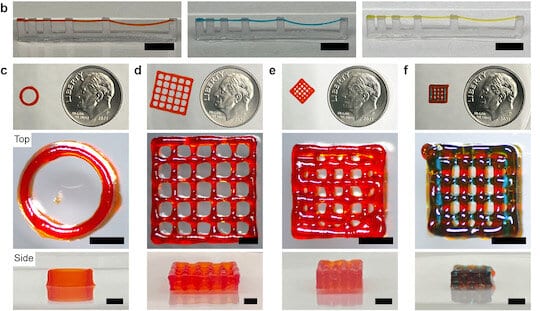
Rice University scientists have developed a revolutionary solution for constructing complex structures for housing cells using a soft, Jell-O-like material. By using a self-assembling peptide ink, researchers in the lab of Rice’s Jeffrey Hartgerink have figured out how to 3D-print well-defined structures, which could be used to grow muscles and — perhaps one day — entire organs fit for transplant.
Advancing regenerative medicine with 3D printing
Adam Farsheed, a Rice bioengineering graduate student and lead author of the study, explains that the secret behind the 3D-printing process lies in multidomain peptides, which are made up of naturally occurring amino acids that are the same building blocks for proteins in the human body. The number of amino acids in a peptide can vary, but most peptides have less than 50 amino acids, whereas proteins are much longer than this figure.
These core peptides used as ink are designed to be hydrophobic (rejecting water) on one side and hydrophilic (attracting water) on the other, which allows them to stack onto one another like a ‘hydrophobic sandwich’ and form long fibers, which then form a hydrogel — a water-based material with a gelatinous texture that can be useful for a wide range of applications, ranging from tissue engineering and soft robotics to wastewater treatment.
“We used peptides as our base material in our 3D-printing inks,” says Farsheed. “Our material can reassemble after being deformed, similar to how toothpaste forms a nice fiber when pushed out of a tube.”
The structures printed with either positively charged or negatively charged multidomain peptides resulted in different outcomes when immature muscle cells were placed on the structures inside a petri dish. The cells remained balled up on the substrate with a negative charge, while on the positively charged material, the cells spread out and began to mature.
“It shows that we can control cell behavior using both structural and chemical complexity,” says Farsheed.
The end goal of the research is to print structures with cells and grow mature tissue in a petri dish. These tissues can then be transplanted to treat injuries, or used to learn about how an illness works and to test drug candidates. “We know that the multidomain peptides can safely be implanted in the body,” says Farsheed. “Our material is so soft, but I recognized that our multidomain peptides are an ideal ink candidate because of the way they self-assemble.”
This groundbreaking work, which appeared in Advanced Materials, represents a significant step forward in 3D printing using self-assembling peptides and has the potential to change the future of regenerative medicine and medical research.
Elsewhere, researchers at the National Eye Institute (NEI), part of the National Institutes of Health, recently used patient stem cells and 3D bioprinting to produce eye tissue. The aim is to use this tissue in the lab to study the mechanisms of blinding diseases, which can then be targeted with new treatments. At North Carolina State University, 3D-printed plant cells to better understand how plant cells communicate with each other, but also with the environment at large.
These developments demonstrate how far bioprinting has come along. However, we’re still ways away from bioprinting organs and other critical tissue for transplantation, which is the ultimate goal of such line of reserach.









